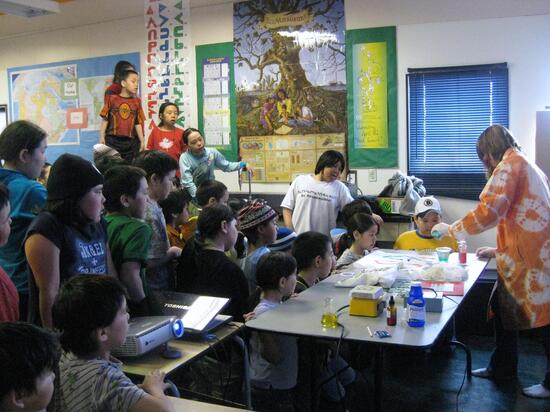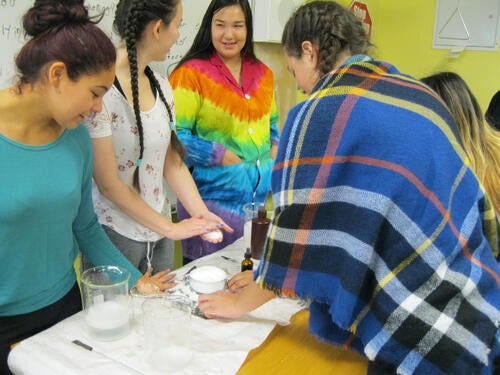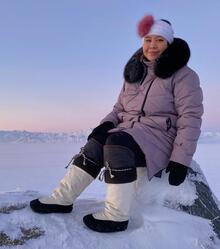How did this compilation on Chemistry and Inuit Life and Culture come to be? A good question! And one which provides important context. This author, Geoff Rayner-Canham, is Professor Emeritus at the Grenfell Campus of Memorial University, Corner Brook, Newfoundland. A significant concern of mine is that, in my view, chemistry is so much more interesting than the endless mole calculations of conventional chemistry courses. I therefore developed a set of household chemistry demonstrations and experiments to take to grade schools across Labrador and western Newfoundland.
 FIGURE 1
FIGURE 1
Chemistry Outreach, 2009, Quqshuun Ilihakvik Junior School, Uqsuqtuuq, ᐅᖅᓱᖅᑑᖅ (Gjoa Haven), Nunavut. Credit: Geoff Rayner-Canham, used with permission
On each Outreach visit, I was accompanied by one or two volunteer chemistry students. The presentations were well received everywhere, but the reception was phenomenal in the Inuit schools of Nunatsiavut, the Inuit self-governing portion of northern Labrador. Eager to extend the Outreach to other Inuit communities, I was able to obtain funding for the Chemistry Outreach team to visit schools across Nunavut. The reception was equally enthusiastic in the Nunavut Inuit schools, one example being shown in Figure 1.
Subsequently, I was asked to devise an Indigenous-contextualized chemistry presentation for a group of Inuit and Innu high school students visiting the Grenfell Campus. This proved highly successful.1 The following year, there was a gifted Inuit student, Chaim Christiana Andersen, from Nain, Nunatsiavut, in one of my chemistry classes. She eagerly agreed to join the Chemistry Outreach team (Fig. 2). During the travels we had many discussions how chemistry really was fundamental to aspects of Inuit life and together we produced a series of articles on specific aspects which would interest the readers of Chem 13 News.
 FIGURE 2
FIGURE 2
Chemistry Outreach, 2017, Lake Melville School, North West River, NunatuKavut, Labrador, with Chaim Andersen in multi-coloured lab coat. Credit: Geoff Rayner-Canham, used with permission
Ms. Andersen moved on in life. However, in Winter 2022, I was asked to co-adapt and co-instruct an Inuit-indigenized version of the Memorial University distance course, Chemistry in Everyday Life. This course was for Inuit students attending the Iqaluit Campus of the Nunavut Arctic College. Among the gifted students in the class was Rosalina Naqitarvik (Fig. 3), who grew up in the High Arctic community of Ikpiarjuk, ᐃᒃᐱᐊᕐᔪᒃ (Arctic Bay). Thus, in addition to having a knowledge-base in science and in Inuit culture, she brought a perspective from a very different part of the Inuit Nunangat (homelands). Together, we constructed some more broadly-based articles on aspects of Inuit culture to provide a second part of the series.
 FIGURE 3
FIGURE 3
Rosalina Naqitarvik in Mittimatalik, ᒥᑦᑎᒪᑕᓕᒃ
(Pond Inlet), Nunavut. Credit: Rosalina Naqitarvik
In contributing my chemistry expertise to this series, I acknowledge that none of it would have been possible, but for the contributions and enthusiasm of my two co-researchers and co-authors: Chaim Christiana Andersen and Rosalina Naqitarvik – my thanks and admiration. I also wish to state my infinite respect for the life and culture of the Inuit peoples of Inuvialuit, Nunavut, Nunavik, Nunatsiavut, and NunatuKavut, and of those Inuit beyond the boundaries of their homelands.
References
1 Rayner-Canham, G.; Taylor, R.; Lee,Y.-R., Making Chemistry Relevant to Indigenous Peoples. Chem 13 News, February 2016.







